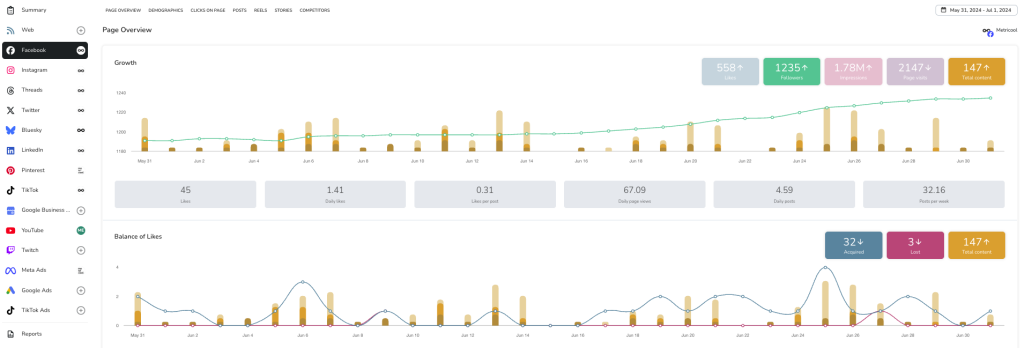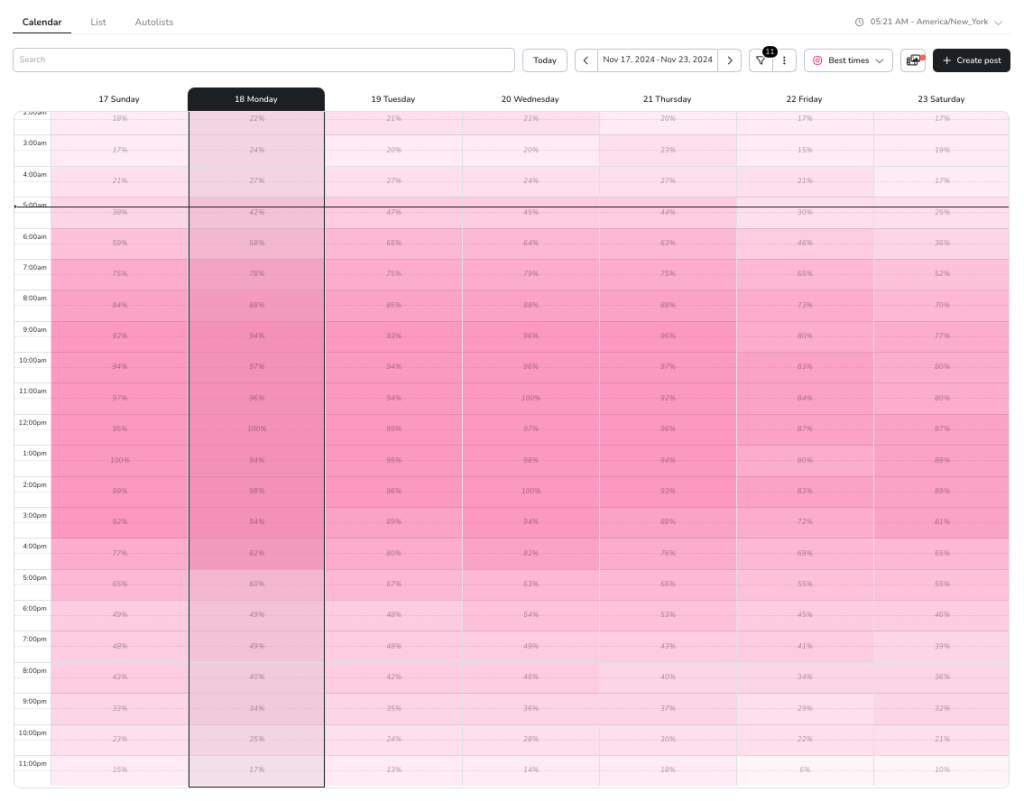Social Media Metrics to Measure: What to Track and Why It Matters

There’s no shortage of data on social media. But not all numbers are useful, and trying to track everything can quickly become overwhelming. The real challenge is figuring out which metrics actually help you understand your performance and using that insight to guide your next move.
Whether you’re growing a brand, selling products, or creating content, this guide breaks down the different types of social media metrics, explains what they mean, and shows you how to use them to shape your strategy.
What Are Social Media Metrics?
Social media metrics are the data points that show how your content is performing across platforms. They help you see what’s working, where you’re falling short, and how close you are to reaching your goals.
Think of them as your content’s report card. Metrics can tell you:
- How many people saw your content
- Who’s interacting with it
- What actions people take after engaging
- How your audience feels about your brand
- Whether your ad budget is actually paying off
But here’s the trick: not every metric matters to every goal. That’s why it’s essential to categorize them by purpose and understand their role in your strategy.
Social Media Metrics to Measure
Tracking your social media performance isn’t just about keeping an eye on likes or followers. To get a full picture of what’s working (and what’s not), you need to look at different types of metrics that tell different parts of the story. Some focus on visibility, others on engagement, conversions, or customer loyalty. Below, we’ve broken it down into six metric categories to help you track the right numbers based on your goals, whether it’s boosting awareness or improving ROI.
1. Awareness Metrics
Purpose: To measure brand visibility and audience growth.
If your goal is to get your brand in front of more people, start here. These metrics show how far your content spreads and whether your online presence is growing. They can help you see if your content is reaching new audiences and if your visibility is growing over time. You can track how specific campaigns or events affect exposure. These metrics play a crucial role in top-of-funnel strategies aimed at building brand recognition.
Metrics to watch:
- Reach: This metric measures the number of unique users who saw your post. Helpful for tracking potential audience size.
- Impressions: This measures total views. Multiple impressions from one user can indicate a strong interest.
- Follower growth: A steady follower rise (not just spikes) indicates sustainable growth.
- Share of voice: This compares your brand’s mentions with competitors in your niche or industry.
- Brand mentions: Includes both tags and plain-text mentions. Use social listening to catch both.
- Audience demographics: This metric helps refine your content and messaging based on who’s actually engaging with you.
- Profile visits: Profile visits are often a stepping stone to follows, DMs, or link clicks.
- Website clicks from social: This tracks interest beyond the platform.
- Top-of-funnel reach: This metric is especially useful when launching new products or campaigns that focus on exposure.
2. Engagement Metrics
Purpose: To understand how well your content connects with your audience.
Engagement metrics provide more than surface-level information. They reflect how much people care about what you’re posting. They help you understand whether your content is connecting in a meaningful way. High engagement typically indicates that the content is both relevant and interesting. These metrics also help you identify which types of posts receive the most interaction and provide insight into your most loyal or vocal followers.
Metrics to watch:
- Likes, comments, shares: These are all reliable signals of interest and interaction.
- Engagement rate: This metric is often more valuable than raw engagement numbers. Use it to benchmark across posts or platforms.
- Saves: Saves are underrated but valuable. People save what they find helpful or inspiring.
- Amplification rate: This measures how often your content is shared, great for spotting viral potential.
- Video views & watch time: A quick view is good, but longer views signal true engagement.
- Story completion rate: This tells you how compelling your story flow is, useful for storytelling or product walkthroughs.
- Live stream engagement: This metric tracks in-the-moment reactions, questions, and feedback in real-time.
- Interactive story elements: Polls, quizzes, and sliders add two-way engagement and boost visibility in the algorithm.
3. Conversion Metrics
Purpose: To measure what happens after someone engages with your content.
Conversion metrics link your social media activity to actual business results. If you’re looking to drive action, such as clicks, signups, and purchases, these are the metrics to focus on. They help you track ROI for both organic and paid content, and show which formats or platforms are turning engagement into meaningful action.
Metrics to watch:
- Click-through rate (CTR): Low CTR? Your call-to-action (CTA) or offer may need work.
- Conversion rate: The most telling metric for performance-based campaigns.
- Cost per conversion: Important for paid media. Aim to keep this as low as possible without sacrificing quality.
- Leads generated: Great for B2B, service providers, and anyone running lead magnets.
- Bounce rate from social: High bounce? Your landing page might not match the content users clicked from.
- Sales from social: Your sales are trackable through UTM links, promo codes, or tools like Metricool that support attribution.
- Cart recovery via social: Great for eCommerce brands using retargeting in ads or DMs.
- Form fills or downloads: Useful if you offer templates, guides, or gated content.
- Instagram link clicks (bio or Stories): A practical measure for creators and small businesses alike.
4. Customer Satisfaction & Retention Metrics
Purpose: To monitor how your audience feels about your brand and whether they stick around.
Customer satisfaction and retention metrics go beyond clicks and sales. They show how you’re doing in terms of loyalty, support, and long-term relationships. These metrics give you a pulse on how people feel about your brand, whether they trust you, and if they’re sticking around. They also reveal how well you’re managing community engagement and customer service.
Metrics to watch:
- Net Promoter Score (NPS): Use surveys to find out how likely people are to recommend you.
- Customer Satisfaction Score (CSAT): Often collected after a purchase or interaction.
- Response rate: Are you answering DMs and comments consistently?
- Response time: Fast replies show customers you care.
- Follower retention rate: Don’t just track new followers, track how long they stick around.
- Unfollow rate: A sudden increase can indicate issues with your content or tone.
- Customer lifetime value (CLV): Especially helpful if you sell products or subscriptions.
- DM interactions: Private messages can signal trust and deeper connections.
5. Brand Health Metrics
Purpose: To get a broader view of how people perceive your brand.
Brand health is about your reputation and the emotional connection you have with your audience. These metrics are especially helpful during product launches, PR campaigns, or crisis management. They help you understand how people perceive your brand overall. This can guide messaging, surface early warning signs, and highlight opportunities for a deeper connection with your audience.
Metrics to watch:
- Sentiment analysis: Tools like Metricool can help detect tone in mentions or comments.
- Conversation volume: Track spikes to spot trending moments: positive or negative.
- Virality rate: This is shares divided by impressions. Virality rate is useful for spotting breakout content.
- Positive vs. negative feedback: Good for assessing content, campaign tone, or influencer partnerships.
- Brand recall: Often measured through surveys after major campaigns or launches.
- Influencer voice alignment: Helps you vet partners and ensure their messaging aligns with your brand.
6. Paid Social Metrics
Purpose: To measure ad performance and budget efficiency.
Paid metrics help you understand whether your ads are doing what they’re supposed to and whether the cost is worth it. They show if you’re getting results for your budget, which audiences respond best, and when it’s time to refresh. These metrics are your go-to when you need to scale or troubleshoot paid campaigns.
Metrics to watch:
- Ad impressions: Useful for measuring exposure in brand-awareness campaigns.
- CTR: For checking whether the creative or CTA works.
- CPC (cost per click): One of the most direct ways to measure ad efficiency.
- CPM (cost per 1,000 views): Good for visibility-focused goals.
- CPA (cost per acquisition): Total spend required to drive a conversion.
- ROAS (return on ad spend): Revenue vs. spend. Especially helpful for eCommerce brands.
- Ad frequency: If users see your ad too often, performance may drop.
- Paid conversion rate: Critical for measuring the bottom line of paid campaigns.
- Scroll-stop rate: How many people pause while scrolling, which helps with creative testing.
How to Choose the Right Social Media Metrics
With so many numbers available in your analytics dashboard, it’s easy to feel overwhelmed. But not every metric deserves your attention. The right ones depend on what you’re trying to achieve.
Before you dive into the data, ask yourself:
💡What’s the goal of this campaign or post?
Are you aiming to raise awareness, build engagement, drive sales, or improve loyalty? Your metrics should match your objective.
💡What action do I want users to take?
Whether it’s watching a video, clicking a link, signing up for a newsletter, or making a purchase, choose metrics that help you track that behavior.
💡Where does this content sit in the customer journey?
A brand awareness post might focus on reach or impressions, while a product-focused post might need clicks or conversions.
Other tips for choosing and tracking social media metrics:
- Don’t try to track everything: It’s tempting to look at every number available, but that can lead to decision fatigue. Stick with metrics that help you make meaningful improvements to your strategy.
- Choose metrics that support action: Vanity metrics (like views or likes on their own) aren’t always helpful unless they tie back to your goals. Look for numbers that indicate progress or signal areas for improvement.
- Set benchmarks for comparison: Your current numbers only tell part of the story. Compare them over time, across different types of content, and against your industry and competitors.
- Track consistently: A single spike or dip won’t tell you much. Monitor your metrics regularly to spot trends and seasonality, and adjust your strategy as needed.
- Use custom tracking links: Tools like UTM parameters can show you exactly where your traffic and conversions are coming from. This can be especially helpful when running multiple campaigns or promoting across different platforms.
- Segment by platform and format: Not all platforms perform the same, and not all formats serve the same purpose. Reels, Stories, carousels, and ads might all require different metrics to measure success.
Common Mistakes When Tracking Social Media Metrics
There’s a ton of data out there, and it’s easy to get lost in the numbers. Recognizing the following common mistakes can help you avoid issues before they arise. It is always easier to prevent the problem rather than having to go back and readjust your social media metrics strategy. Here are a few common pitfalls to watch out for:
Tracking Everything Under the Sun
Just because you can measure a metric doesn’t mean you should. Focus on the KPIs that directly align with your goals. If you spend too much time tracking every single metric, you run the risk of spreading yourself too thin. By focusing on the metrics that matter, you will have more time to create quality content and interact with your followers.
Ignoring Context
A sudden jump in engagement might look great until you realize it’s people posting negative comments under your post. The numbers don’t always tell the whole story. Always look at the numbers and then dive deeper to understand the driving force behind them. Moreover, a significant increase in engagement may be due to spam or a bot attack, so be cautious and regularly review your metrics and posts.
Mixing Organic and Paid Results
Blending the organic and paid results together makes it difficult to see what’s actually working. Keep them separate so you can identify which content is driving performance and which might be merely boosted by your budget. When you know where your real traction comes from, you can fine-tune your budget and creative for better overall results.
Staring at the Data but Not Using It
Collecting metrics is great, but they don’t mean much if you’re not taking action on them. The real power of data comes from applying it. Use your insights to test new formats, tweak your CTAs, or refine your posting times. Even minor adjustments, made consistently, can lead to big improvements over time. Don’t just monitor your data, make it work for you!
Track Your Social Media Metrics With Metricool
If you’re tired of jumping between apps, screenshots, and spreadsheets just to understand how your content is performing, Metricool brings everything together in one place. It gives you a full view of your social media performance without the hassle of manual tracking.
Connect all Your Social Accounts
From Instagram and Facebook to TikTok, LinkedIn, Pinterest, YouTube, and more, you can sync your accounts to a centralized dashboard that shows the full picture. No need to log in and out of each platform or juggle separate analytics tabs. Everything’s in one place, making it easier to track performance at a glance and manage your content workflow more efficiently.

Track Organic and Paid Content
Whether you’re posting Reels or running Facebook Ads, Metricool lets you measure performance across formats and campaigns. See which content brings results and where you’re getting the best return on effort (or budget). You can compare organic reach with paid results, monitor ad spend, and understand which channels or posts are driving the most meaningful actions like clicks, conversions, or sales.
Discover Best Posting Times
Metricool analyzes when your audience is most active based on your own data and not generic suggestions. Use this insight to schedule posts when they’re more likely to get seen and engaged with. By posting at the right time, you enhance visibility and increase the likelihood of receiving likes, comments, shares, and clicks without needing to constantly test and guess.

Monitor Competitors
Curious how your performance stacks up? The competitor analysis tool shows you how similar brands are doing, helping you spot trends, gaps, and opportunities to differentiate yourself. Track their follower growth, post frequency, engagement, and more, all without leaving your dashboard. It’s a simple way to stay informed and sharpen your own strategy.
Create Custom Reports
Save time with ready-to-share reports that include visuals, charts, and export options. Customize them to focus on the data that matters most to your team or clients.
Add your own branding, choose the metrics you want to highlight, and deliver clear insights that are easy for anyone to understand, which is perfect for internal reviews or client presentations.
Keep Track of Growth Over Time
Spot patterns across weeks, months, or specific campaigns. Whether you’re tracking a product launch or testing a new content format, Metricool makes it easy to measure results and adjust your strategy. You’ll get a better understanding of what’s working, what’s not, and how your performance evolves over time so you can make smarter decisions moving forward.
FAQs about Social Media Metrics
How Often Should I Check My Social Media Metrics?
You should check your social metrics at least once a week to stay on top of trends and spot quick wins. Weekly check-ins keep your strategy flexible, while monthly or quarterly reports give you a clearer picture of overall growth and long-term progress.
What’s the Difference Between Reach and Impressions?
The difference between reach and impressions comes down to who saw your content and how many times they saw it. Reach measures the total number of unique users who saw your post, while impressions track the total number of times your post was displayed, including repeat views. Think of reach as unique viewers, and impressions as the total number of views.
Which Social Media Metric Is the Most Important?
The most important metric depends on your goals. If you’re focused on brand awareness, prioritize metrics like reach and impressions. If you want to drive action, keep an eye on click-through rate (CTR) or conversion rate. The key is matching your metrics to what you actually want to achieve.
Do Social Media Metrics Really Matter for Small Accounts?
Yes, social media metrics matter just as much for small accounts as they do for big ones. Tracking your metrics helps you understand what types of content resonate, when your audience is most active, and how to grow strategically over time. Even small insights can lead to big improvements.
How Can I Measure ROI From Social Media?
To measure ROI from social media, track how your content drives real actions like clicks, signups, or sales. The easiest way is to use UTM links or an analytics tool like Metricool, which connects your social media engagement data to performance and conversions, allowing you to see exactly what’s paying off.
Ready to Make Your Metrics Work Harder?
You have the data. Now it’s time to turn it into results. Metricool makes social media tracking simple by putting all your analytics, reports, and insights in one easy-to-use dashboard. No more hopping between platforms or drowning in spreadsheets! With Metricool, you’ll see what’s working, what’s not, and how to get more ROI from every post. Sign up for your free Metricool account and start making data-driven decisions that actually move the needle!

